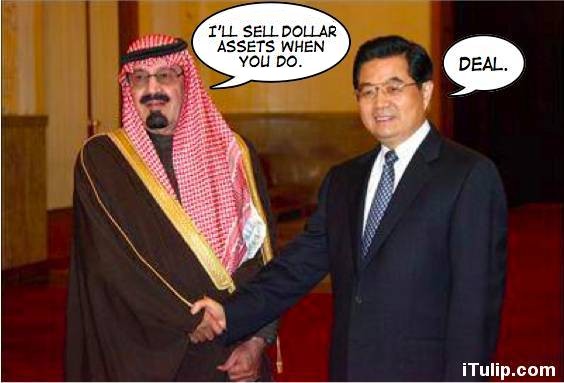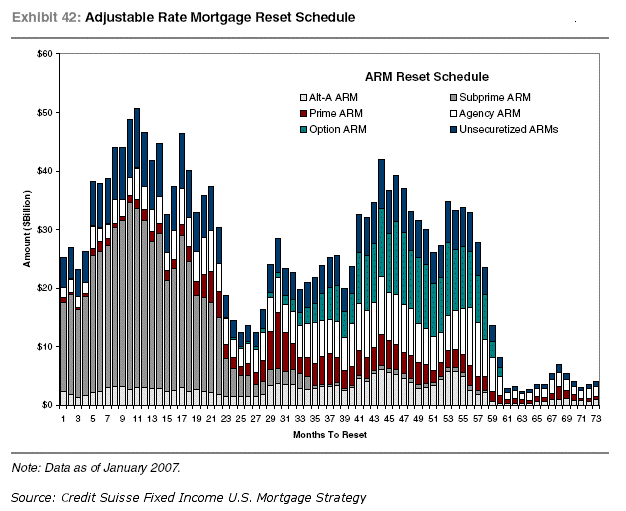 |
Fears of dollar collapse as Saudis take fright
Sept. 20, 2007 (Ambrose Evans-Pritchard - Telegraph UK)
Saudi Arabia has refused to cut interest rates in lockstep with the US Federal Reserve for the first time, signalling that the oil-rich Gulf kingdom is preparing to break the dollar currency peg in a move that risks setting off a stampede out of the dollar across the Middle East.
"This is a very dangerous situation for the dollar," said Hans Redeker, currency chief at BNP Paribas.
"Saudi Arabia has $800bn (£400bn) in their future generation fund, and the entire region has $3,500bn under management. They face an inflationary threat and do not want to import an interest rate policy set for the recessionary conditions in the United States," he said.
The Saudi central bank said today that it would take "appropriate measures" to halt huge capital inflows into the country, but analysts say this policy is unsustainable and will inevitably lead to the collapse of the dollar peg.
AntiSpin: Here at iTulip we call this process "Poom" and it ain't pretty. "Poom" is the back end of the Ka-Poom Theory disinflation/inflation cycle that is both monetary cause and effect of the bubble cycle. The bubble cycle replaced the business cycle as the focus of monetary policy since the finance-based economy, popularly mis-labeled the "service economy," aka the FIRE Economy, became the centerpiece of US national industrial/economic policy starting around 1980. Sept. 20, 2007 (Ambrose Evans-Pritchard - Telegraph UK)
Saudi Arabia has refused to cut interest rates in lockstep with the US Federal Reserve for the first time, signalling that the oil-rich Gulf kingdom is preparing to break the dollar currency peg in a move that risks setting off a stampede out of the dollar across the Middle East.
"This is a very dangerous situation for the dollar," said Hans Redeker, currency chief at BNP Paribas.
"Saudi Arabia has $800bn (£400bn) in their future generation fund, and the entire region has $3,500bn under management. They face an inflationary threat and do not want to import an interest rate policy set for the recessionary conditions in the United States," he said.
The Saudi central bank said today that it would take "appropriate measures" to halt huge capital inflows into the country, but analysts say this policy is unsustainable and will inevitably lead to the collapse of the dollar peg.
The first Ka-Poom was 2000 - 2006, with disinflation 2000 - 2001 following the crash of the stock market bubble and inflation in everything from oil to gold to houses during the re-inflation cycle 2002 - 2006.
The disinflation phase of the current bubble cycle started after the housing bubble peaked in mid 2005. As the disinflation was gradual due to the nature of the market for houses, which are not marked to market all at once like stock portfolios but only gradually, wealth and employment and thus demand were not suddenly hit. There was little spill-over into the so-called "real economy" such as occurred after the crash of the stock market bubble, so only a muted disinflationary phase occurred. Until May, that is, when the credit markets got the idea to price the creative securities that had for years been the engine of all of the credit for the housing, private equity, and other bubbles. The markets priced them at zero and the credit markets seized up. Then, after a brief pause–quite suddenly and with great force–the demand implosion began in August.
Anyone paying attention could see this coming a mile away. A leading indicator we've been tracking is housing permits, which by plunging 25% below last year's issuance early this year and staying there confirmed, with other data, our Oct. 2006 projection of a recession Q4 2007. Then in August we noted iTulip Prosper Lending Group default rates soaring along with duration of unemployment numbers, a leading indicator of future unemployment.
The cascading economic impact of simultaneously collapsing housing, private equity, and other bubbles is The Iceberg. As recently as two weeks ago the Fed had apparently not spotted it as Bernanke continued to give speeches indicating a focus on inflation, which is in our view well justified. In fact, we actually thought he was serious, and the iTulip ShadowFed predicted a .25% cut. We thought the Fed's worry about US creditors would trump concerns about the economy. After spotting the iceberg, the Fed re-calculated: if the US economy is sinking like the Titanic, no one is going to want to lend the US money anyway. That is probably true. But lenders may not want to buy anything denominated in dollars if they believe that the only thing really supporting the dollar is their purchases of dollar assets, that the US isn't willing to accept the consequences of the asset bubbles and instead wants to dump them on its creditors. Just ask the Saudis.
That is what "Poom" is about. The no-win choice after a bubble pops between re-inflation to hold off a run-away debt deflation and even more inflation and dollar depreciation as a side effect of re-inflation policy.
1999 Ka-Poom Theory also posits that a final "Poom" happens–the terminal bubble in the bubble cycle–when the Fed attempts to re-inflate the economy via rate cuts and dollar depreciation when the dollar is weak and inflation is already running high–as it is now. Instead of causing long rates to fall, the cuts have the opposite result: long rates rise as the bond market prices in inflation fueled by dollar depreciation. Mortgage rates rise and the housing market tanks some more. A self-reinforcing cycle starts.
The IMF warned of this last year:
IMF Identifies Risk of `Disorderly' U.S. Dollar Drop
September 13, 2006 (Bloomberg)
A "disorderly'' drop in the dollar is the biggest risk to world financial markets, the International Monetary Fund said, urging policy makers to prepare and act quickly when asset prices slump.
Investors are buying U.S. bonds under the assumption that the dollar won't slide, and a drop in the currency might turn into a rout as foreign investors and central banks move to cut losses, the global financial watchdog said.
"A low-probability but potentially high-cost risk to the global financial system is that a dollar decline could become self-reinforcing and hence disorderly,'' the IMF said in its Global Financial Stability Report today.
Last week, IMF Managing Director Rodrigo De Rato singled out lopsided global trade and investment flows, protectionist sentiment and high energy prices as sources of concern to an otherwise benign outlook for the global economy. The IMF says the U.S. current account deficit, running at a record rate, needs to narrow.
Will hitting the iceberg at 4.75 knots versus 5.25 knots make the difference between sinking and staying afloat? Will it matter if the US economy floats but the trade-weighted dollar is half or a quarter of what it is today?September 13, 2006 (Bloomberg)
A "disorderly'' drop in the dollar is the biggest risk to world financial markets, the International Monetary Fund said, urging policy makers to prepare and act quickly when asset prices slump.
Investors are buying U.S. bonds under the assumption that the dollar won't slide, and a drop in the currency might turn into a rout as foreign investors and central banks move to cut losses, the global financial watchdog said.
"A low-probability but potentially high-cost risk to the global financial system is that a dollar decline could become self-reinforcing and hence disorderly,'' the IMF said in its Global Financial Stability Report today.
Last week, IMF Managing Director Rodrigo De Rato singled out lopsided global trade and investment flows, protectionist sentiment and high energy prices as sources of concern to an otherwise benign outlook for the global economy. The IMF says the U.S. current account deficit, running at a record rate, needs to narrow.
We await the next Fed Flow of Funds report, due out Dec. 7, for our answer.
iTulip Select: The Investment Thesis for the Next Cycle™
__________________________________________________
For a book that explains iTulip concepts in simple terms see americasbubbleeconomy
To receive the iTulip Newsletter or iTulip Alerts, Join our FREE Email Mailing List
Copyright © iTulip, Inc. 1998 - 2007 All Rights Reserved
All information provided "as is" for informational purposes only, not intended for trading purposes or advice. Nothing appearing on this website should be considered a recommendation to buy or to sell any security or related financial instrument. iTulip, Inc. is not liable for any informational errors, incompleteness, or delays, or for any actions taken in reliance on information contained herein. Full Disclaimer



Comment